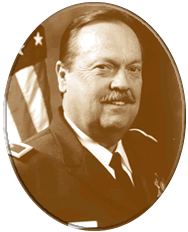Larry D. Smith was the 11th Sheriff of Riverside County, California. He was also the first Sheriff-Coroner of the California County.
Smith spent his entire adult life serving as a Deputy Sheriff before his election as the Sheriff of one of the nation’s fastest growing counties. Today Riverside County is America’s 10th largest county with 2.5 million residents.
He spent a great deal of his career working on — and later —running jails in the county. He came to understand those inmates doing county time. He believed in education and training for those in custody. He realized those remanded to his care would be getting out of jail and needed education and skills to be able to reenter the workforce.

Larry D. Smith
Smith also knew he needed a department that looked much more like the community he was elected to serve. He tasked his undersheriff and executive officer with staffing a Commission on Recruiting, Retention, and Diversity. He appointed civic leaders of all nationalities to create a road map to diversity.
The Commissioners came from the minority and majority community. Lee Simmons, former aide to President Gerald Ford and businessman & Mayor Percy Byrd of Indian Wells were just two of the many members of this body. Both Simmons and Byrd were African Americans.
Many in the department didn’t think Sheriff Smith was doing the right thing by asking “outsiders” how to diversify the department he was elected to lead. Neither did Human Resources team members from the county.
Smith cared about what department members had to say but firmly pushed back against those who were threatened by his efforts to diversify.
Commissioners helped develop a diversity platform by working with the community and clergy. More Latinos, African Americans, Native Americans, and Asians were needed to fill the ranks of one of America’s largest law enforcement agencies.
As Smith passed the torch to Sheriff-elect Bob Doyle, a new recruitment campaign was well underway. The campaign featured radio, television, and outdoor advertising which encouraged minorities to join the department as peace officers, correctional officers, coroners staffers, and support team members.
The effort paid off and the department began to look more like the community it was serving. The template called for working closely with institutions like The Black Voice News, La Opinion, La Prensa Hispana, and other minority media outlets to attract a more divorce force.
Testing sites were moved to locations easier to reach for rural county residents. No corners were cut and new team members still hit the same high standards to gain employment.
Today, Sheriff Chad Bianco leads a department that is more diverse than it has ever been. He also has the opportunity to build upon the positive legacies of Sheriffs Larry Smith and Bob Doyle.
Bianco has already shown his team members and public he leads by example. He was with his deputies during the recent demonstrations. He leads from the front and not the rear. He has already banned forms of restraint that can lead to the death of someone being taken into custody.
As America addresses law enforcement’s use-of-force programs and polices, it can look at the work done by prior law enforcement leaders. Look at what worked and refine and improve those policies and programs. Politicians should find reforms not ask for new programs that are unfunded mandates.
For decades, sheriffs and Police Athletics Leagues have been model programs for inter-city youth. Explorer programs have also been models for youth in our communities nation wide. Many of the boys and girls that were in Athletic Leagues and Explorer programs are today’s leaders in education, business, and our communities.
Law enforcement careers are honorable professions. It takes a person with good moral character and integrity to enter the career field. The reality is that some of those who serve will make split-second decisions that could take a life.
A very tiny minority will abuse the authority vested in them and must be removed from public service when that is deemed the case. That, too, takes a process.
We cannot expect perfection from those who serve in law enforcement. We cannot expect police or sheriff’s deputies to serve flawlessly.
Neither should we expect these ladies and gentlemen to be afraid to use the force required when needed to protect the public they serve and those they serve with.
That may not be a popular position but it is realistic. You are asking police or deputies to make split second decisions and on occasion those split second calls will be wrong.
However, you should also look closely at a law enforcement professional’s intent when he or she must use force. That’s why departments and police commissions review officer-involved use of force.
It’s a review and investigation that helps find out what happened, why, and if the actions taken warrant termination or filing criminal filing. Most use of force cases are justified.
Clearly, we can hold our elected sheriffs and our appointed police chiefs to a higher standard than those they lead. For it is the chief or sheriff that set polices on use of force and for policing the police.
More work will also be required on how demonstrators are safely “managed” as they exercise their constitutional rights. However, when peaceful demonstrations become riots, occupations, or encampments, peace officers must do their jobs to protect lives and property.
We all realize the best way to demonstrate is peacefully. America’s greatest civil rights leader believed in peaceful demonstrations. His life and later his tragic death resulted in long overdue civil rights reforms that brought about more change and more opportunity.
As Americans and America address how to make our nation a place that “liberty and justice for all” means the same things to all of us, we will continue to see division and strife. Now is the time to take opportunity and equality to the next level.
Image Sources
- Larry Smith: RSO
- Team: Pixaby

![Smith Sought Diversity in His Ranks [Opinion]](https://ukenreport.com/wp-content/uploads/2020/06/team-4200837_1280-1280x640.jpg)


![Rancho Mirage Mayor Defends Council [Opinion]](https://ukenreport.com/wp-content/uploads/2024/03/Rancho-Mirage-City-Council-Chambers-440x264.jpg)
![Medal of Honor Day Remembered [Opinion]](https://ukenreport.com/wp-content/uploads/2024/03/Medal-of-Honor-Day-440x264.jpg)

